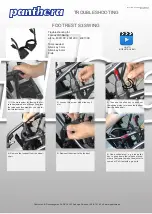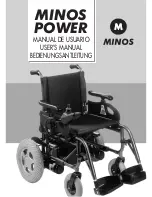
ENGLISH
19
Life R Rev.2.0
Adjusting The Footrest
WARNING!
• Attendant: Do not stand on the footboard! Even if the
user is sitting in the chair, there is still a risk of tipping
over and injury.
• User: When transferring, do not stand on the footboard,
there is a risk of tipping over and injury.
Releasing the screw (1) will allow you to adjust the footrest to
correspond to the length of your lower leg and re-attach the
footrest. The angle of the footrest may be individually adjusted
by loosening screws (2). The side protection (3) on the footrest
prevents the feet slipping off accidentally. Make sure that after
any adjustment work, all screws are tightened correctly (see the
page on torque) (Fig. 6.17 - 6.18).
Footplate Adjustment
2
3
Fig. 6.18
Fig. 6.17
1
Lightweight footrest
The footrest angle can be adjusted by loosening the screws (2).
Side protection panels can be fitted to the footrest using the
mounting holes (3). These prevent the feet slipping off
accidentally, (Fig. 6.18.1). Make sure that after any adjustment
work, all screws are tightened correctly (see the page on
torque).
Fig. 6.18.1
2
2
3
3
Castor
Castor, Castor adapter, Castor
fork (Fig.6.19)
From time to time the wheelchair
may veer slightly to the right or left,
or the castors may flutter.
This may be caused by the
following:
•
The forward or reverse wheel
motion has not been set properly.
•
The castor angle has not been
adjusted properly.
•
Castor and/or rear wheel air pressure is incorrect; wheels do not
turn smoothly.
The optimum adjustment of the castors is required so that the
wheelchair runs in a straight line. The castors should always be
adjusted by an authorised dealer.
The castor plates must be re-adjusted, and the wheel locks must be
checked any time the rear wheel position has been altered. Check
the setting of the castor adapter (1) by placing a set-square next to
it and looking at it from the front. Make sure that the adapter is at
right angles to the floor. By undoing the screws (2) and moving the
adapter, you can then re-adjust the wheels to their optimum position,
by adjusting the corresponding teeth segments. Make sure that after
any adjustment work, all screws are tightened correctly (see the
page on torque).
Fig. 6.19
90°
2
1
















































